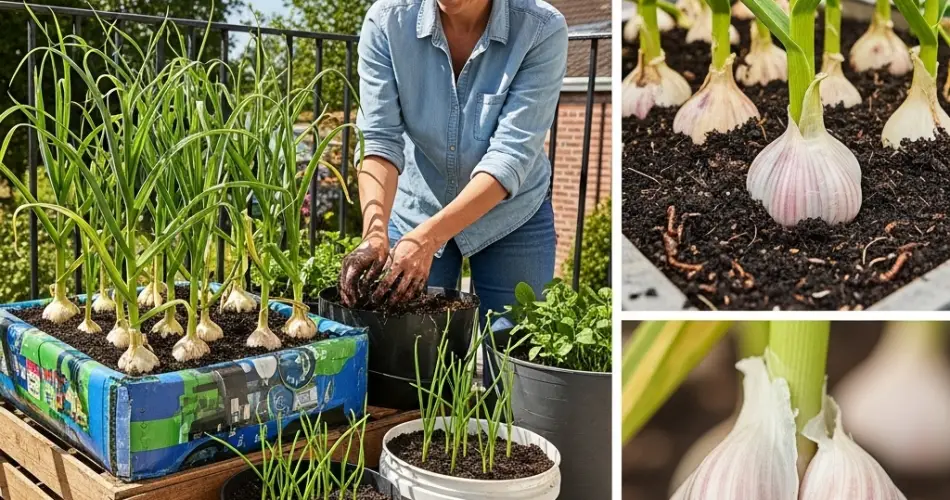Garlic is one of the most versatile and rewarding crops you can grow in your garden or home. Not only does it add flavor and health benefits to your meals, but it’s also relatively easy to cultivate once you know the right techniques. The great news is that with the proper care and timing, you can grow garlic almost all year round.
If you love cooking with fresh garlic or want to start your own garlic-growing journey, learning these essential secrets will help you cultivate healthy, flavorful garlic bulbs continuously. Here’s everything you need to know to become a successful garlic grower.
Why Grow Garlic?
Garlic is a hardy and adaptable plant that can be grown in various climates and soil types. It has natural pest-repelling properties, which can benefit other plants in your garden. Additionally, fresh garlic from your own garden tastes better and contains more nutrients than store-bought varieties, which often lose potency during long storage.
Growing garlic yourself also saves money and reduces dependence on commercial agriculture, making it a sustainable choice for food lovers.
Types of Garlic to Grow
Before planting, it’s important to choose the right type of garlic for your climate:
-
Hardneck Garlic: Thrives in colder climates and produces a stiff flower stalk called a scape. It has a stronger flavor and produces fewer but larger cloves.
-
Softneck Garlic: Better suited for warmer climates, softneck garlic produces many small cloves and stores longer. It doesn’t produce a scape.
-
Elephant Garlic: Actually a type of leek, elephant garlic has very large bulbs and a milder flavor.
Selecting the right variety will ensure your garlic grows well and suits your culinary preferences.
When to Plant Garlic for Year-Round Harvest
Garlic is typically planted in the fall or early spring, depending on your region. To enjoy garlic year-round, you can stagger planting times or grow different varieties that mature at different rates.
-
Fall Planting: Planting in autumn allows bulbs to develop strong roots during winter and grow vigorously in spring. This is ideal in temperate climates.
-
Spring Planting: In warmer areas, spring planting is preferred to avoid bulb rot and heat stress.
-
Staggered Planting: By planting cloves every few weeks, you can have a continuous supply of fresh garlic throughout the year.
How to Plant Garlic
-
Prepare the Soil: Garlic prefers well-drained, fertile soil with plenty of organic matter. Loosen the soil to about 15 cm (6 inches) depth.
-
Select Healthy Cloves: Break apart the bulb and choose the largest, healthiest cloves for planting.
-
Plant Cloves Pointed End Up: Insert cloves about 5 cm (2 inches) deep and 10-15 cm (4-6 inches) apart.
-
Mulch: Cover the planting area with mulch to protect bulbs during winter and conserve moisture.
Caring for Garlic Plants
-
Watering: Keep soil moist but not waterlogged. Garlic needs consistent moisture during active growth.
-
Fertilizing: Apply balanced fertilizer or compost during planting and again in early spring.
-
Weeding: Keep the garlic bed free from weeds to avoid competition for nutrients.
-
Pest and Disease Control: Watch for fungal diseases and pests like onion thrips. Use natural remedies or organic treatments as needed.
-
Scape Removal: For hardneck garlic, remove flower stalks (scapes) as they appear to encourage bulb growth.
Harvesting and Storing Garlic
Garlic is ready to harvest when the lower leaves turn yellow and dry, usually in mid to late summer. Gently loosen the soil and lift bulbs with a garden fork.
-
Curing: Allow harvested bulbs to dry in a warm, airy place for 2-3 weeks. This hardens the skin for storage.
-
Storage: Store garlic in a cool, dry place with good air circulation. Softneck varieties can last up to 9 months; hardneck varieties about 6 months.
Tips to Grow Garlic All Year Round
-
Use Containers: Garlic can be grown in pots or containers indoors with enough sunlight.
-
Green Garlic: Harvest young garlic shoots (green garlic) before bulbs mature for fresh flavor.
-
Replant Cloves: Save the largest cloves from your harvest for the next planting cycle.
-
Rotate Crops: Avoid planting garlic in the same spot consecutively to prevent soil-borne diseases.
Benefits of Growing Your Own Garlic
Growing garlic at home means fresh, organic garlic without pesticides. It’s also satisfying to watch the growth cycle from planting to harvest. Plus, garlic’s natural compounds may promote health benefits like improved immunity and cardiovascular health.
Conclusion
Garlic is a fantastic plant to grow all year round with a bit of planning and care. By selecting the right varieties, planting at the appropriate times, and following proper care techniques, you can enjoy an endless supply of fresh, flavorful garlic from your garden or home.
Try these tips today and discover the joy of cultivating garlic for your kitchen and well-being. Once you master these secrets, you’ll never want to stop growing garlic!



